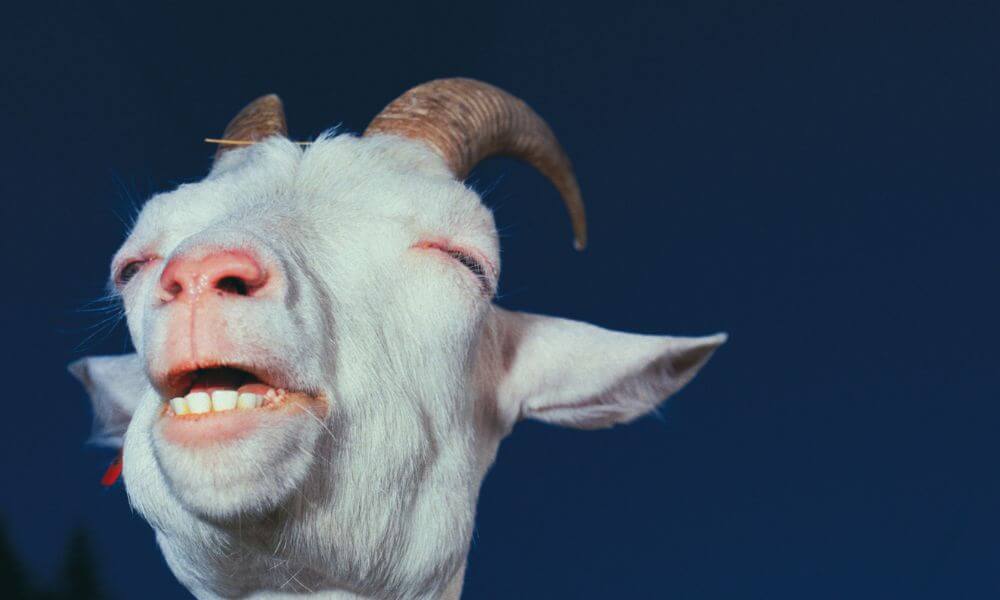If you’ve ever looked at a goat up close, you’ll have seen their weird but interesting eyes.
Some people may even find it unsettling to look into a goat’s eyes because of their unique pupil shape.
Don’t worry though: a goat’s weird eyes don’t mean there’s something wrong with it.
In fact, a goat’s eyes have developed perfectly to benefit the goat in its habitat and its place on the food chain.

What do a goat’s eyes look like?
Unlike human eyes, which have round pupils and are on the front of our heads, a goat’s eyes are on the side of its head and have rectangular pupils.
These rectangle pupils look like a horizontal black stripe across the middle of their eye.
A goat’s eyes will also have some unique colors.
Goat eyes can be different shades of brown, amber, and even blue.
Sometimes a goat’s eyes may appear white with only some specks of blue in them.
Some goat breeds are more inclined to a certain eye color than others.
Goats aren’t the only animals with special pupils.
Cats and snakes both have vertical slit eyes that help them see in the dark.
When there’s a lot of light around, their eyes narrow to a thin slit.
At night, when there are low levels of light, the slit widens into an oval to allow in as much light as possible, giving the animal excellent night vision.
Do goats have eyelids and eyelashes?
Yes, goats actually have three eyelids.
One of their eyelids acts almost like sunglasses, helping reduce glare from the sun and other light sources.
The other two are involved in blinking, lubrication, and protection.
Goats have eyelashes just like many other mammals.
Their eyelashes vary in length depending on breed but are typically one-third as long as the width of their eye.
Their eyelids can produce some problems though.
Goat eyes are susceptible to inverted and outward eyelids, which can irritate and even blind a goat.
If you notice a goat’s eyes being very runny, irritated, and cloudy, they may be experiencing an eye problem.
Why are a goat’s pupils rectangles?
A goat’s pupils are shaped like a horizontal rectangle because of the visual benefits it provides.
The wider pupils let in a much wider field of view.
Because their eyes are located on the sides of their head, goats have an almost complete circular view of their surroundings.
Their field of view can be up to 340 degrees with no blind spot straight in front like horses.
There is an interesting concept called parallelism that a goat achieves with their eyes.
The rectangular pupil is positioned so that it’s perfectly level with the ground if the goat bends down to eat.
That way, they can have the best view of their surroundings when they are at their most vulnerable.
Goats do have a narrow blind spot behind their heads, but this is not an issue since they wouldn’t have been able to see past their bodies when grazing anyway.
This rectangular pupil also gives the goat great night vision.
Even so, goats prefer to take shelter at night to avoid predators and other dangers.
Most other grazing animals also share this rectangular pupil, although with some differences.
Because each animal has a different shaped head, their eyes vary in viewing angles, blind spots, and parallelism.
If your goat ever has round pupils in a situation where they shouldn’t be round, it should be a concern.
Goat pupils always return to their usual rectangular shape unless there is something wrong with the goat.
Consult a vet immediately if you notice a goat having eye problems.
Are a goat’s eyes better than a human’s eyes?
Because goats have to rely on their eyes as their first line of defense against predators, they are well suited to spotting other creatures around them.
We can’t compete with their excellent 340-degree horizontal view.
Humans can only see 120 degrees horizontally, although this is sufficient for our purposes.
Goats can rotate their eyes up to 50 degrees in every direction, which is more than our 32 to 48 degrees of rotation.
Horizontal pupils are also great at blocking out the sun’s sharp rays during the day.
As the sun is above their head, goats won’t even be able to see it due to their mostly horizontal view.
Our round eyes let in all the light from the direction we’re looking at, which sometimes includes annoyingly sharp sun rays.
Goats don’t have depth perception across all 340 degrees of view though.
Most goats only have depth perception for about 60 degrees in front of their heads (compared to our around 100-degree depth perception), but that’s enough to keep an eye on where they’re going.
This narrow range of depth perception is actually very good given the position of a goat’s eyes, which is wider than a human’s and better at determining depth.
Goats like keeping an eye on the humans around them and will keep track of where you are at all times.
Even if you are partially obscured behind an obstacle, they will likely know that you are there.
Can a goat’s eyes move separately?
Yes, a goat can control their eyes individually, letting them keep track of multiple views at once.
A goat’s brain is uniquely built to be able to see as much as possible, and being able to move eyes separately is a big part of their fantastic visual abilities.
While some people may find a goat’s eyes freaky, it’s just part of being a goat.
This unique trait is an excellent way for goats to keep track of what’s going on around them and react before danger can reach them.
They will even use their keen vision to keep track of you, so don’t be surprised if they always know where you are.
